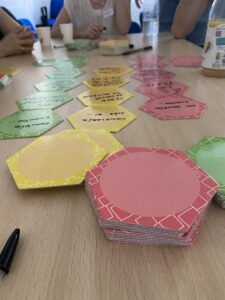On July 15, 2025, the AMUSENS project took a significant step forward by hosting the co-design workshop, “Your Air, your Insights: What should your ideal sensor look like?”. Held in Barcelona, the session brought together citizens with different backgrounds to collaboratively define user needs and expectations for personal gas sensors.
The AMUSENS project, funded by the European Union, aims to develop a versatile gas sensor platform that combines a multi-pixel approach with artificial intelligence. This workshop focused specifically on the use case of assessing personal exposure to indoor air pollutants. The ultimate goal is to create a tool that not only monitors air quality but also raises awareness and empowers users to adopt healthier practices.
Gathering the Voices: The Participants
To ensure authentic and valuable feedback, a dedicated one-month recruitment campaign was launched. The campaign reached out to potentially interested individuals through email, while also leveraging the LinkedIn profiles of AMUSENS and Science For Change to attract participants.
This effort culminated in a group of 11 participants who, after signing an informed consent form, gathered for the 2 and a half hour workshop. They were arranged into two tables, each guided by a dedicated facilitator, to ensure an interactive and productive environment. As a token of appreciation for their valuable contributions, each participant received a €20 voucher.
A Hands-On Journey to the Ideal Sensor
The workshop, facilitated bya Sergi Lopez, Johana Burbano, and Cristine del Amo, from Science For Change, was structured around a series of dynamic activities designed to explore every facet of the user experience. The session followed a clear agenda, starting with a welcome and an icebreaker asking participants why they were interested in measuring air pollutants.
The core of the workshop was divided into five key phases:
- Dynamic 1: The User Journey
Participants engaged in a role-playing game, using predefined “user personas” with specific daily routines. The objective was to map out a realistic user journey, identifying when and where a person might be exposed to pollutants and how they would interact with a sensor alert in that moment. This phase focused on understanding the context of use and the decisions a user might make upon receiving an alert. - Dynamic 2: The Prototype
The focus then shifted to the physical device. Participants voted on whether they would prefer a fixed or a portable (wearable) sensor. Using SFC Tools, they brainstormed ideas on where to place the sensor (e.g., on a wrist, in a pocket, on a kitchen wall) and how it should alert them (e.g., sound alarm, light signal). - Dynamic 3: The Features
This dynamic delved into the specific characteristics and usability requirements of the sensor. Participants listed essential features and key requirements. - Dynamic 4: The Format
Interaction with data was the central theme here. The group explored how data should be presented—through numerical values, colour-coded alerts, or trends over time. They also discussed preferences for multi-pollutant tracking versus a single key indicator and whether data should be available in real-time or with a delay. - Dynamic 5: The Trust
The final phase addressed a crucial factor: user trust. Participants identified what would motivate them to use the sensor and what would make them doubt its readings.
Paving the Way for a User-Centric Design
By the end of the session, invaluable insights have been gathered. The expected outcomes included a priority list of sensor features and requirements, and clear recommendations for the sensor’s design, placement, and user interaction. Crucially, the workshop also identified key challenges and strategies for building user trust in air quality data.
This co-creation session was a vital step, ensuring that the technology developed within AMUSENS is not only innovative but also practical, intuitive, and genuinely aligned with real-world user needs. The insights gathered will directly inform the next stages of the project.

